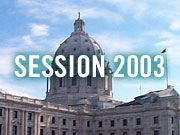Audio
Photos
Your Voice
| |||||||||||||||||||||||||||||||||||||||||||||||
Times of high anxiety in the land of higher education
May 21, 2003
The cost of going to a public college in Minnesota will likely go up hundreds of dollars this fall. Gov. Tim Pawlenty is expected to sign a higher education funding bill that cuts each of the state's public university systems 15 percent. The bill that passed at the end of the regular session provides $10 million more than Pawlenty had proposed. Still, critics say the cuts are short-sighted and will lead to an erosion of quality at the state's colleges.
St. Paul, MN. — The 2004-05 higher education budget is leaning toward Robert Bruininks' worst expectations. The University of Minnesota's president calls the $196 million cut very severe.
"Our budget will return to what it was roughly five years ago, in 1998. And if you adjust the budget from the state for inflation, using a very very modest correction, this takes us back to funding levels in 1986. So these are very deep, deep, cuts," he said.
 | |||
Bruininks says he will be recommending tuition increases ranging from about 13 to 15 percent, varying by campus and program.
Anne Meehan is about to start a masters program in elementary education at the U. She says she'll try to manage the cost increase through student loans. She says she's angry about the cuts in state funding that will require her to pay higher tuition. This is the third double-digit tuition increase at the public colleges in as many years.
"I think that they always go for the people who have no voice. I mean, the students, there's not really an organization that's protecting the students as a whole. So, who's going to fight for the students? Certainly the people who have already gone to school could care less about what the tuition is because they want the money for other wasteful spending," she said.
Sen. Sandy Pappas, DFL-St. Paul, shares Meehan's outrage. As chair of the Senate's Higher Education Budget Committee, she and other DFLers refused to sign off on the bill.
 | |||
"By forcing these cuts you're going to see less sections available, larger class sizes. So you're going to be in a situation where students are paying more and getting less."
House Higher Education Finance Chair Doug Stang is more optimistic. The Republican from Cold Spring says the 15 percent decrease is still $10 million more than Gov. Tim Pawlenty's proposal. And he says the cuts should force a reassessment of how the U of M and the Minnesota State Colleges and Universities System are run.
"Even at times when we made significant investments with new dollars, there were increased tuitions at very high rates. So, I think we're at a point where we have to acknowledge that we cannot continue to do it the way that we have been doing, that changes have to be made throughout the system. Maybe it's a matter of prioritizing programs, maybe it's a matter of determining that we can't offer every program at every campus," Stang said.
The U of M's Robert Bruininks and MnSCU Chancellor James McCormick both say they've been working hard and creatively to reduce costs on campus. They say there will be cuts to programs, staff and faculty.
|
Maybe it's a matter of determining that we can't offer every program at every campus.
- Rep. Doug Stang |
McCormick says while closing any of MnSCU's 53 campuses is not in the short-term planning, it could become at least part of a future answer to a lack of state funding.
"What we've discovered is that closing a campus has a devastating impact on the community where the campus is located. Of course, the other issue is that some students may not be able to attend college at all if the nearby campus closes. So it's a serious matter, but I think given these circumstances, all of these options have to be considered."
MnSCU's 15 percent biennial cut translates into a drop of $189 million. McCormick says, like the U, there will be tuition increases throughout the MnSCU system in the 15 percent range. But, he says that bump in revenue won't cover the system's deficit brought on by the drop in state funding.
There is a mixed blessing in the new funding bill. The state financial aid grant program was given a $40 million increase. The problem though, all sides agree, is that amount won't even come close to assisting all the students who'll need help covering the 15 percent tuition increase.
|
News Headlines
|
Related Subjects
|


